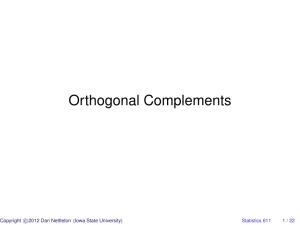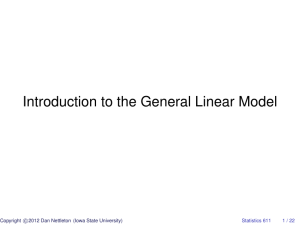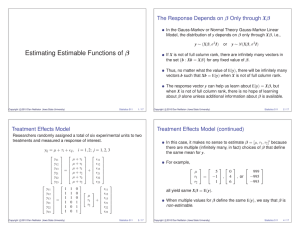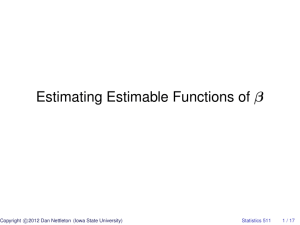Document 10639892
advertisement
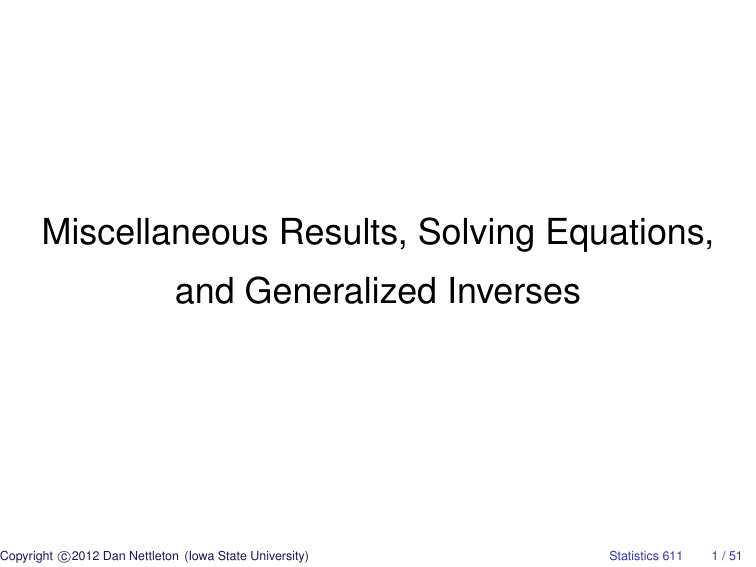
Miscellaneous Results, Solving Equations, and Generalized Inverses c Copyright 2012 Dan Nettleton (Iowa State University) Statistics 611 1 / 51 Result A.7: Suppose S and T are vector spaces. If S ⊆ T and dim(S) = dim(T ), then S = T . c Copyright 2012 Dan Nettleton (Iowa State University) Statistics 611 2 / 51 Result A.8: Supposem×n A and b satisfy m×1 Ax + b = 0 ∀ x ∈ Rn . m×n m×1 Thenm×n A =m×n 0 and b = 0. m×1 m×1 c Copyright 2012 Dan Nettleton (Iowa State University) Statistics 611 4 / 51 Corollary A.1: Ifm×n B andm×n C satisfy Bx = Cx ∀ x ∈ Rn , then B = C. c Copyright 2012 Dan Nettleton (Iowa State University) Statistics 611 6 / 51 Corollary A.2: Supposem×n A has full column rank. Then AB = AC =⇒ B = C. c Copyright 2012 Dan Nettleton (Iowa State University) Statistics 611 8 / 51 Lemma A.1: C0 C = 0 =⇒ C = 0. Proof of Lemma A.1: Let ci denote the ith column of C. Then the ith diagonal element of C0 C is c0i ci . ∵ C0 C = 0, c0i ci = 0 ∀ i = 1, . . . , n. Now c0i ci = 0 ∀ i =⇒ ci = 0 ∀ i =⇒ C = 0. c Copyright 2012 Dan Nettleton (Iowa State University) Statistics 611 10 / 51 Another Result on the Rank of a Product Suppose rank(m×n A ) = n and rank( C ) = k. Then k×l rank( B ) = rank(ABC). n×k Proof: HW problem. Corollaries: If A is full-column rank, rank(AB) = rank(B). If C is full-row rank, rank(BC) = rank(B). c Copyright 2012 Dan Nettleton (Iowa State University) Statistics 611 11 / 51 Solving Equations: Consider a system of linear equations Ax = c, wherem×n A is a known matrix and c is a known vector. c Copyright 2012 Dan Nettleton (Iowa State University) m×1 Statistics 611 12 / 51 We seek a solution vector x that satisfies Ax = c. If m = n so thatm×n A is a square and ifm×n A is nonsingular, then A−1 Ax = A−1 c =⇒ x = A−1 c is the unique solution to Ax = c. c Copyright 2012 Dan Nettleton (Iowa State University) Statistics 611 13 / 51 Ifm×n A is singular or not square, Ax = c may have no solution or infinitely many solutions or a unique solution. c Copyright 2012 Dan Nettleton (Iowa State University) Statistics 611 14 / 51 A system of equations Ax = c is consistent if there exists a solution x∗ such that Ax∗ = c. A systems of equation Ax = c is inconsistent if Ax 6= c ∀ x ∈ Rn . c Copyright 2012 Dan Nettleton (Iowa State University) Statistics 611 15 / 51 Result A.9: A system of equations Ax = c is consistent iff c ∈ C(A). Provide an example m×n A, c 3 Ax = c is inconsistent. m×1 Provide an example m×n A, c 3 Ax = c is consistent. m×1 c Copyright 2012 Dan Nettleton (Iowa State University) Statistics 611 16 / 51 Generalized Inverse A matrix G is a generalized inverse (GI) of a matrix A iff AGA = A. Every matrix has at least one GI. We will use A− to denote a GI of a matrix A. c Copyright 2012 Dan Nettleton (Iowa State University) Statistics 611 19 / 51 If A is nonsingular, then A−1 is the unique GI of A. c Copyright 2012 Dan Nettleton (Iowa State University) Statistics 611 20 / 51 Result A.10: Suppose rank(m×n A) = r. If A can be partitioned as A= C r×r D r×(n−r) E F (m−r)×r , (m−r)×(n−r) where rank(r×r C) = r, then " G= n×m # C−1 0 0 0 is a GI ofm×n A. c Copyright 2012 Dan Nettleton (Iowa State University) Statistics 611 22 / 51 Proof of Result A.10: " AG = #" # C−1 0 E F " = I EC−1 " ∴ AGA = C D I 0 0 # 0 . 0 #" # 0 C D EC−1 0 E F " = C D # E EC−1 D . We need to show EC−1 D = F. c Copyright 2012 Dan Nettleton (Iowa State University) Statistics 611 23 / 51 First note that rank(r×r C) = r =⇒ rank([C, D]) = r ∵ [C, D] has at least r LI columns and at most r LI rows. (rank([C, D]) ≥ r and rank([C, D]) ≤ r =⇒ rank([C, D]) = r.) c Copyright 2012 Dan Nettleton (Iowa State University) Statistics 611 24 / 51 Now rank " #! C D E F = r =⇒ each row of [E, F] is a LC of the rows of [C, D]. Thus ∃ a matrix K 3 K[C, D] = [E, F] ⇐⇒ [KC, KD] = [E, F] ⇐⇒ KC = E, KD = F. c Copyright 2012 Dan Nettleton (Iowa State University) Statistics 611 25 / 51 Now KC = E ⇐⇒ K = EC−1 . Together with KD = F, this implies EC−1 D = F. c Copyright 2012 Dan Nettleton (Iowa State University) Statistics 611 26 / 51 Permutation Matrix A matrixn×n P is a permutation matrix if the rows of P are the same as the rows ofn×n I but not necessarily in the same order. c Copyright 2012 Dan Nettleton (Iowa State University) Statistics 611 27 / 51 Example: 0 1 0 P= 1 0 0 . 0 0 1 1 2 3 4 5 6 7 8 If A = 5 6 7 8 , then PA = 1 2 3 4 . 9 10 11 12 9 10 11 12 Order of rows of PA are permuted relative to order of rows of A. c Copyright 2012 Dan Nettleton (Iowa State University) Statistics 611 28 / 51 Example: " # 0 1 0 1 2 3 P= 1 0 0 , B = 4 5 6 . 0 0 1 " # 2 1 3 . Then BP = 5 4 6 Order of columns of BP are permuted relative to order of columns of B. c Copyright 2012 Dan Nettleton (Iowa State University) Statistics 611 29 / 51 A Permutation Matrix is Nonsingular The rows (and columns) of a permutation matrix are the same as those of the identity matrix. Thus, a permutation matrix has full rank and is therefore nonsingular. Furthermore, if P = [p1 , . . . , pn ] is a permutation matrix, P−1 = P0 ∵ p0i pj = c Copyright 2012 Dan Nettleton (Iowa State University) 0 if i 6= j 1 if i = j. Statistics 611 30 / 51 Result A.11: Suppose rank(m×n A) = r. There exist permutation matricesm×m P and Q such n×n that " PAQ = C D # , E F where rank(r×r C) = r. Furthermore, " G=Q C−1 0 0 0 # P is a GI of A. c Copyright 2012 Dan Nettleton (Iowa State University) Statistics 611 31 / 51 Proof of Result A.11: Because rank(A) = r, there exists a set of r rows of A that are LI. Let P be a permutation matrix, 3 the first r rows of PA are LI. Let H be the matrix consisting of the first r rows of PA. Then rank(H) = r. c Copyright 2012 Dan Nettleton (Iowa State University) Statistics 611 32 / 51 This implies that ∃ a set of r columns of H that are LI. Let Q be a permutation matrix 3 the first r columns of HQ are LI. Then the submatrix consisting of the first r rows and first r columns of PAQ has rank r. c Copyright 2012 Dan Nettleton (Iowa State University) Statistics 611 33 / 51 Thus we can partition PAQ as " By Result A.10, # C−1 0 0 0 c Copyright 2012 Dan Nettleton (Iowa State University) " # C D E F , where rank(r×r C) = r. " is a GI for PAQ = C D E F # . Statistics 611 34 / 51 PAQ = " # C D " ⇐⇒ A = P −1 C D # Q−1 E F E F " # C−1 0 ∴ AQ PA = 0 0 " # " # " # −1 C D C 0 C D = P−1 Q−1 Q PP−1 Q−1 E F 0 0 E F " #" #" # C−1 0 C D −1 −1 C D =P Q E F 0 0 E F " # −1 C D =P Q−1 = A. E F c Copyright 2012 Dan Nettleton (Iowa State University) Statistics 611 35 / 51 Use Result A.11 to find a GI for 1 1 3 4 A= 2 2 6 8 . 3 3 0 12 c Copyright 2012 Dan Nettleton (Iowa State University) Statistics 611 36 / 51 Algorithm for finding a GI of A: 1. Find an r × r nonsingular submatrix of A, where r = rank(A). Call this matrix W. 2. Compute (W −1 )0 . 3. Replace each element of W in A with the corresponding elements of (W −1 )0 . 4. Replace all other elements in A with zeros. 5. Transpose resulting matrix to get A− . c Copyright 2012 Dan Nettleton (Iowa State University) Statistics 611 42 / 51 Result A.12: Let Ax = c be a consistent system of equations, and let G be any GI of A. Then Gc is a solution to Ax = c, i.e., AGc = c. c Copyright 2012 Dan Nettleton (Iowa State University) Statistics 611 43 / 51 Result A.13: Let Ax = c be a consistent system of equations, and let G be any GI of A. Then x̃ is a solution to Ax = c iff ∃ z 3 x̃ = Gc + (I − GA)z. c Copyright 2012 Dan Nettleton (Iowa State University) Statistics 611 45 / 51 Prove that a consistent system of equations Ax = c has a unique solution if and only if A is full-column rank and infinitely many solutions if and only if A is less than full-column rank. c Copyright 2012 Dan Nettleton (Iowa State University) Statistics 611 48 / 51
